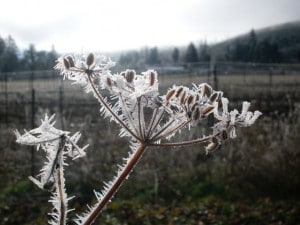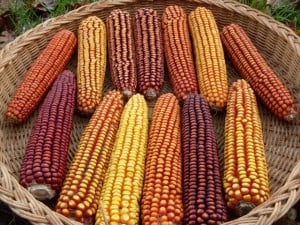2013 Rye Ramble (reprinted from the Adaptive Seeds printed catalog.)
—-
Bringing Biodiversity Back for Real, Explained…
We don’t simply write long variety descriptions because it is interesting and we don’t choose rare varieties because they are simply novel.
I feel that seeds, with the biodiversity and cultural knowledge they embody, are a doorway into the mystical realms of our reality. That sounds a little funny and I am not trying to lose you into a woo-woo made-up universe here. I am just trying to explain some reasons for why we do what we do. And predictably every year we discover more reasons for doing this seedy thing.
 We write long descriptions and choose rare varieties for the sake of conservation, food security, the joy of the experience, and the encouragement from others to continue the hard work; these are all good reasons. But these reasons are like the layers of a leek stem. Every reason we give is a layer of the leek and we keep getting closer and closer to the core. One day we will get to the apical meristem and continue to peel and there will be an empty space where there was a growth point, mysteriously keeping its secrets from us. And yes, this is yet another reason we give ourselves to continue this journey, because we won’t know every reason.
We write long descriptions and choose rare varieties for the sake of conservation, food security, the joy of the experience, and the encouragement from others to continue the hard work; these are all good reasons. But these reasons are like the layers of a leek stem. Every reason we give is a layer of the leek and we keep getting closer and closer to the core. One day we will get to the apical meristem and continue to peel and there will be an empty space where there was a growth point, mysteriously keeping its secrets from us. And yes, this is yet another reason we give ourselves to continue this journey, because we won’t know every reason.
So why do we write these long descriptions when other seed companies write one sentence and sometimes even get the color wrong? What it comes down to for me is that cultural knowledge about seed varieties has eroded even faster than the seed varieties themselves.
An agro-ecosystem, like any ecosystem, can lose genetic diversity. (You probably already know this next part and it’s probably why you came to our seed catalog.) Over the past few centuries the industrialization of agriculture has contributed to the near total loss of all agricultural biodiversity. You might say it is an exaggeration to say near total, but according to the Food and Agriculture Organization (FAO) of the United Nations, we have lost 75% since 1900 and continue to lose 2% every year. When considering losses before 1900, and that most of these estimates include the varieties kept in gene banks that are considered “saved from extinction,” then you must estimate that nearly all agricultural biodiversity has been lost.
There is a big difference between biologically lost and culturally lost. If you think about how few varieties are still being grown by farmers and gardeners that are saved year to year to further adapt them to local conditions, then one might say nearly all diversity has gone culturally extinct, too.
Of course there are different levels of genetic erosion. The loss of genes within a variety is less obvious than the loss of varieties altogether, but it is also important to work to preserve diversity on this level. Then there is the extinction of species or the loss of entire plant types.
 When thinking of all of the layers to this leek stem, it is easy to see why most people would rather contribute money to a conservation organization than do the real work of preserving and increasing the biodiversity that does exist. But when it comes to preserving this type of agricultural diversity, the real work is not nearly as difficult as preventing the clear-cutting of rainforests:The real work can be as easy as saving seed and breeding new varieties of vegetables in your garden.
When thinking of all of the layers to this leek stem, it is easy to see why most people would rather contribute money to a conservation organization than do the real work of preserving and increasing the biodiversity that does exist. But when it comes to preserving this type of agricultural diversity, the real work is not nearly as difficult as preventing the clear-cutting of rainforests:The real work can be as easy as saving seed and breeding new varieties of vegetables in your garden.
Here at Adaptive Seeds, we are engaged in that real work of trying to bring biodiversity back to growing food. Many seed companies have taken up this charge lately and we may have come to a turning point. However, the conversation about seed diversity has been profoundly shallow. How do we bring biodiversity back for real and not just for show? Focusing on heirloom tomatoes and squash is nice but the myriad of other crops and different kinds of heritage beyond heirloom is where the real magic is.
Here are some of the questions I ask myself when I want to dig deeper:
– How many species of food crops are in my life and what is the real quality of the crops I eat and grow?
– Should seed be relegated to gene banks and history books or be associated with antique collectors, and why does the term “heirloom” bother my sensibilities?
– How do I want to evolve culturally with my seeds as they adapt biologically to the environment we share?
It is now obvious that the missing diversity of our food system effects us profoundly. The current industrial food system works in opposition to our ability to adapt to the changing environment and the loss of biodiversity in this situation could have devastating consequences for us humans in the short term. In the face of an uncertain future, we will need the resources at hand, and the knowledge of what to do with these resources, to make the best choices for our communities.
This is where the cultural aspect comes in. I see our catalog not only as a resource for biodiversity but also as a resource of some of the cultural knowledge we still retain. I see both parts as essential, each tragically flawed without the other. Additionally, when a seed is grown it is new and excited for the possibilities ahead. This gives us countless, priceless opportunities as “evolutionaries.” It can lead to many more paths up the mountain, many more options than we currently have –a diversity.
This is where we need your help. The more diversity grown in our communities and the more experiences we have with that diversity the better. We will have a more profound relationship with nature and we will exist within nature instead of trying to be separate from it. We will also open up the possibilities for a future based on a foundation of biological and cultural inheritance. That is a future I want to be a part of and I hope you do too.
Andrew Still – January 2013 – Adaptive Seeds Catalog
Great post. Will reshare 🙂